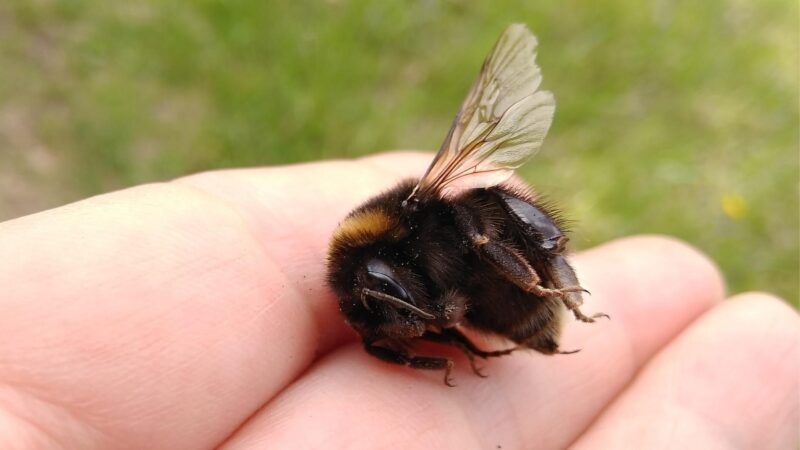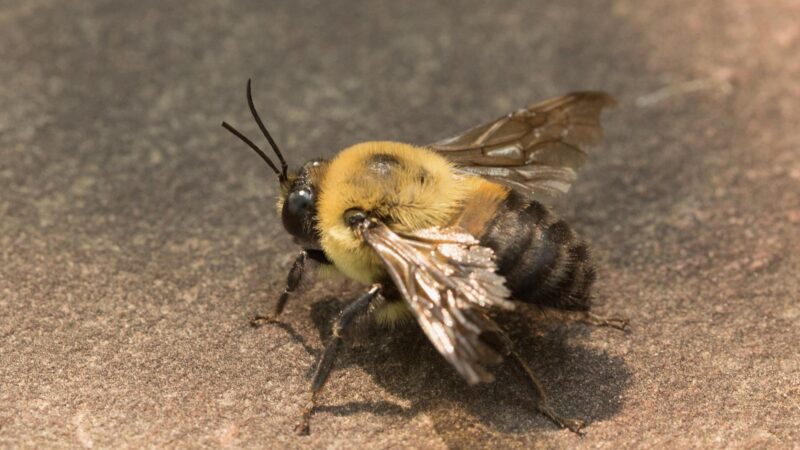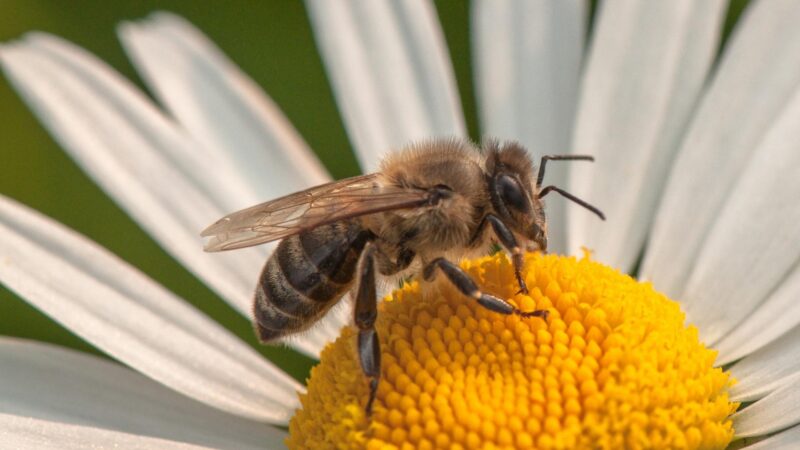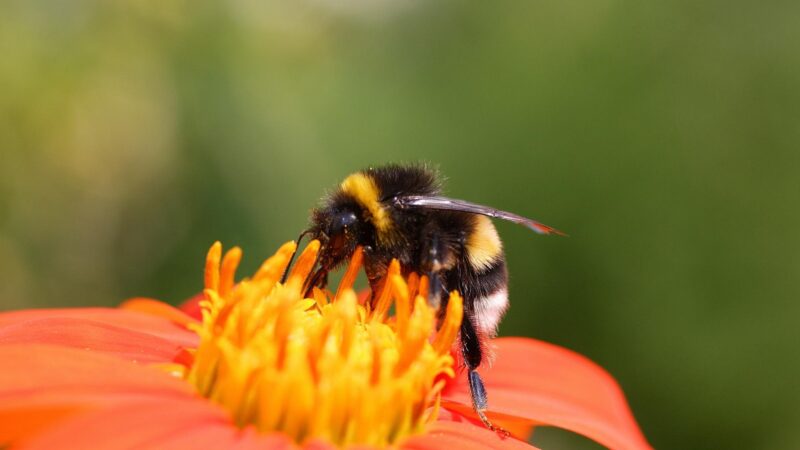Finding dead bumblebees can easily cause alarm. This is especially true if you find a couple of them lying in one spot. Was there a predator nearby? Are the flowers around sprayed with pesticides? These are just some of the questions that come to mind.
In the case of a single dead bumblebee, it may simply have chosen a flower in your garden as a final resting place. And if you see many of them, it may be because they died in a nearby hive and were thrown out by other bees.
While it seems alarming, the reason for finding dead bumblebees is most likely because they have died of natural causes. But what exactly do you do with a dead bumblebee? Can a dead bumblebee still sting you? This article will answer these questions and more.
Table of Contents
Why Do You Keep On Finding Dead Bumblebees?

There are several reasons why you keep on finding dead bumblebees, and these may either be old age, lack of an ideal food source, pathogens, and loss of habitat, to name a few.
Old Age
A bumblebee’s lifespan averages around 12 weeks, while some subspecies only survive for 28 days. The only exception is the queen, who can live for up to twelve months. That means a bee reaches its peak age within one to three months – and they die soon after.
If you keep finding dead bumblebees after every month, then it’s most likely due to old age.
Lack of Nutritional Food Source
Studies reveal that bumblebees prefer nutrient-rich pollen, and that draws them more to certain flower types. Without their ideal food source nearby, bumblebees are willing to search long enough until they find it.
However, because of their large round bodies and small wings, a bumblebee can only fly for less than an hour, even on a full stomach. If they don’t find food within this period, they become weak enough and unable to fly. And when a bee is on the ground, there’s only a small chance for survival.
Pathogens
Like humans, bees also fall victim to pathogens like viruses and bacteria. These pathogens can make them ill and weak and sometimes even lead to their deaths. There are also recorded instances of entire bee colonies having the disease, especially when one bee infects the rest.
Loss of Habitat
Another reason for finding dead bees is their loss of habitat. Bumblebees establish their homes in a place where they can have easy access to flowers they can forage. But with modernization and industrialization, bumblebees are having a hard time searching for their ideal habitats.
If you come across a dead bee in your garden, there’s a chance that it foraged your flowers for food. However, the flowers may not have been enough for it.
Others
Other reasons why you may find dead bees in your garden include an attack from a predator or that they were sprayed with pesticides. In the case of a dead cluster of bees, there’s a chance that there’s a hive nearby, and that these were thrown out by living bees to free up space inside the hive.
What Do You Do With a Dead Bumblebee?
When you see a bumblebee lying down, the first thing you have to do is to determine whether it is really dead or simply resting. This is especially true if you see it lying inside a flower. In this case, wait for a few moments to observe whether the bee starts moving or not.
Once you’re sure that a bumblebee is dead, you have to dispose of it, preferably by throwing it in a compost pile where it cannot be accidentally stepped on by anyone.
A word of caution, dead bumblebees still have their stingers attached, and these can still inject venom into your body if improperly handled. Thus, make sure that you’re wearing the right protective gear when you’re trying to dispose of the dead bee.
How Do You Know if a Bumblebee is Dying?

It’s easy to tell when a bumblebee is dying because they look weak and lethargic. This contrasts with the image of a “busy bee” since a dying bee often flies close to the ground and is too weak to fly from flower to flower.
Where Do Bees Go to Die?
It has been observed that bees go to lie down on flowers when they are about to die. But in some cases, bees die because they can no longer gain altitude. And once they go down, they do not survive long enough.
There are also instances when they choose to stay in their hives to die, especially in instances when they were defending the hive from a predator or when they became infected by other bees. But in any case, there’s no exact place where bees go to die. That may also be one of the reasons why you can find some of them near your garden.
Can Dead Bees Still Sting?
Even when they’re already dead, the bee’s stinger is still connected to the venom sac. As such, you have to handle a dead bee carefully to prevent getting stung accidentally.
Of course, this is with the exception of the honeybee that died because it has stung someone. Unlike other bee species, honey bees have a barbed stinger that detaches after they have punctured skin. As such, they lose their stinger and die soon after. Without its stinger, a dead honey bee can no longer sting you.
At What Temperature Do Bumblebees Die?

It has been observed that a majority of bees die as the temperature drops. Studies show that some bumblebee species die at around 23°F while others start freezing at 19°F. That’s why it’s common to see a couple of dead bumblebees once the temperatures drop in the late fall season.
However, this is with the exception of the queen who can hibernate throughout the winter, as well as some winter bumblebee species.
Do Bees Have Blood?
Bees have what is called hemolymph, which is a blood-like substance common in bees and other invertebrates. It is an extracellular fluid, and it is what is closest to the blood that bees have. Unlike blood, hemolymph does not contain hemoglobin.
It is likewise interesting to note that bees do not have a central nervous system composed of nerves and veins. What they do have is an open nervous system. This allows all of the hemolymph fluids to circulate freely inside the body.
Are Bumblebees Friendly?

Bumblebees are quite friendly. In fact, they are considered gentle bee subspecies and are generally docile towards humans. However, they will not hesitate to defend themselves in case of an attack or threat nearby.
In any case, it must also be noted that you should be conscious when there’s a bumblebee or a hive of bumblebees nearby. They can be easily threatened by loud noises or by swift action – such as the sound of a mower or if you try to swat them away.
Do Bees Sting for No Reason?
Bees will not sting you for no reason. Bees only resort to stinging when they feel threatened or aggravated. So if you see a bee nearby, leave it alone, and it won’t cause you any harm.
What Smells Do Bees Hate?
Bees are attracted to sweet floral scents because it reminds them of the flowers they forage. But if you’re wondering how you can draw away bees without hurting them, you can consider the following scents for your home or garden.
- Peppermint. Peppermint has a fresh minty scent that surprisingly repulses bees. You can either plant it or spray peppermint oil around your house to repel bees. Fortunately, peppermint isn’t toxic to bees, so you know you won’t do them any harm.
- Citronella. Another non-toxic smell that bees hate is the scent of citronella. Citronella is known to repel mosquitos but it is also strong enough to keep bees away.
- Cinnamon. Cinnamon has a spicy-sweet scent that bees seem to hate. Despite the sweet notes from cinnamon, bees do not like how it smells, so you can sprinkle some of it in your garden to drive bees away.
- Lemon. Lemons have a tangy fruity scent that bees find pungent enough to avoid. So if you want to keep bees away, leave a few slices by your window, porch, or garden. The best part is that lemons are always available, so you won’t have a hard time looking for them.
Related: Natural Ways to Get Rid of Bumble Bees | A Detailed Guide
What is the Difference Between a Honey Bee and a Bumblebee?
It’s easy to tell the difference between a bumblebee and a honey bee. At first glance, you can easily tell because bumblebees have large, round, and furry bodies compared to the long and slender bodies of honey bees.
But perhaps the biggest difference between the honey bee and the bumblebee lies in its survival after stinging an enemy. In the case of bumblebees, they have smooth stingers that allow them to sting repeatedly. But in the case of honey bees, their stingers are barbed, causing them to anchor onto the skin of their target. As a result, part of their abdomen becomes ruptured as they fly away – causing them to die soon after.
To give you a more visual idea of the differences between the bumblebee and the honey bee, you can refer to the table below:
| Bumblebee | Honey Bee | |
| Body | Round-shaped, large, covered in bristle-like fur | Long, slender, only the upper half is covered mostly in fur |
| Color | Black and yellow stripes, less number of stripes | Black and yellow stripes, has more stripes |
| Lifespan | Worker: 28 days to 12 weeks Queen: Up to 12 months | Worker: 60 to 200 days Queen: 2 to 3 years |
| Stinger | Smooth, does not detach upon stinging | Jagged or barbed, detaches upon stinging |
| Multiple Stings | Yes | No |
There’s no need to panic in case you see a couple of dead bumblebees near your home. In most cases, it simply means that there is a hive nearby, and they have died there of natural causes. But regardless of how they died, make sure to dispose of them the right way – otherwise, you might get stung because of improper handling.
List of Sources
Picky Eaters: Bumble Bees Prefer Plants With Nutrient-Rich Pollen